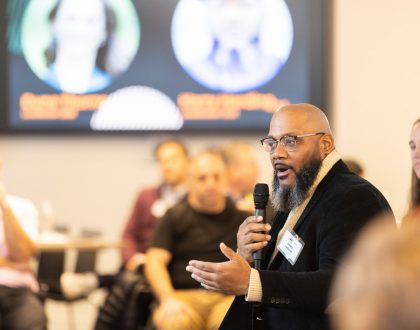YW Boston’s Accessibility Guide: Meetings and Events

At YW Boston, we’re committed to delivering meetings and events that are accessible to all people. This means that everyone who attends a meeting or event has the opportunity to fully participate. We believe that individuals and organizations planning events should strive to practice accessibility as much as possible.
That’s why YW Boston created an accessibility guide that will help you with your planning. With this guide, you and your team can ensure that everyone at your events and meetings will feel welcome and supported. To view our latest resource, click here or scroll below for more.
Understanding Accessibility
Accessibility is defined as “the quality of being able to be entered or used by everyone, including people who have a disability” (Cambridge Dictionary). It’s important to note that most definitions of accessibility are specifically inclusive of people with disabilities. This acknowledgement helps ensure that accessibility centers the people who need it most. However, people with disabilities aren’t the only ones who need accessibility – it’s for everyone! Even though it’s often designed to meet the particular needs of people with disabilities, able-bodied and neurotypical people benefit from accessibility, too.
In general, accessibility is meant to be inclusive of as many people as possible. As human beings, we have a wide range of lived experiences that influence how we experience a situation, which can all be factored into accessibility. Be aware that there are many applications for accessibility, both physical and digital, and there are different considerations and best practices for each application. The focus of our new accessibility guide is meetings and events.
Applying Accessibility to Meetings and Events
An accessible meeting or event is one where each attendee can show up and participate as fully as any other attendee, regardless of their individual circumstances. One way to approach planning an accessible meeting or event is to consider it through each phase of an attendee’s experience. In our new “Accessibility Guide: Meetings and Events,” our recommendations are segmented into three categories: before the event, during the event, and after the event. That way, your event is accessible from start to finish. In other words, think of accessibility from pre-registration all the way through the post-event thank-you email.
Keep in mind that not all accessibility considerations are necessary or plausible for all events. There is not a “one size fits all” approach to accessibility. We recommend reviewing the accessibility guide at the beginning of your planning process to identify which guidelines to follow for your specific circumstance. Then, build those best practices into your planning timeline so you don’t lose track of them and continue to reference the guide as you go along.
In addition, we suggest integrating accessibility into all meetings and events, including regularly scheduled internal meetings. By consistently practicing accessibility, it can become fundamental to how you meet. Plus, practicing accessibility internally will set you up for success when the time comes to demonstrate your commitments externally through larger public events.
Getting Started
YW Boston’s “Accessibility Guide: Meetings and Events” provides detailed recommendations for making your meetings and events more accessible. Some of our recommendations are applicable to all events (in-person or virtual). Additionally, there are separate considerations for in-person events and virtual events. As with any skill, learning how to implement accessibility takes time and practice. To get started, select a few simple recommendations that you can incorporate into any meeting or event. Here are some ideas:
- Include an accessibility statement on all communications related to the meeting or event.
- If possible, electronically share materials (agenda, slides, handouts, etc.) before the event.
- At the start of the program, remind attendees when the meeting begins and ends.
You can continue to build off these ideas as you refine your approach to accessible meetings and events. The recommendations in our accessibility guide are not exhaustive – if you have other ideas for meeting accessibility, please contact us at info@ywboston.org and share them with us. Remember, even small adjustments can make a big difference.
Meetings-and-Event-Accessibility-Guide